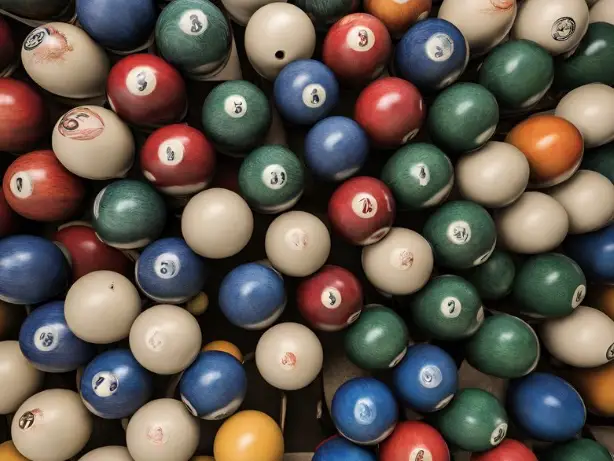What Type of Ball is Used in Duckpin Bowling: A Clear Explanation
When you think of bowling, you might picture a standard 10-pin bowling alley with large, heavy balls. However, there are many variations of bowling, including duckpin bowling. If you’ve never played before, you might be wondering what type of ball is used in duckpin bowling.
The answer is simple: duckpin bowling balls are smaller and lighter than traditional bowling balls. According to the National Duckpin Bowling Congress, regulation duckpin bowling balls weigh between 2 and 4 pounds, and have a maximum diameter of 4.75 inches. This is in contrast to the larger, heavier balls used in traditional 10-pin bowling. The smaller size of the balls makes it easier to handle and control them, which can be especially helpful for younger or less experienced bowlers.
Overall, duckpin bowling is a fun and challenging variation of the classic game. If you’re interested in trying it out, be sure to find a local alley that offers duckpin bowling, and give it a shot with the smaller, lighter balls.

Duckpin Bowling Essentials
If you are new to duckpin bowling, it is essential to understand the basics of the game, including the type of ball used, lane specifications, gameplay, scoring, rules, and regulations, equipment, and accessories. Here is a brief overview of what you need to know.
Duckpin Balls Characteristics
Duckpin balls differ from the conventional bowling ball in size and weight. The ball has no finger holes, is made of hard rubber, and weighs 1.7 kg. The diameter of the ball is between 4 7/8 and 5 inches. The smaller size and weight of the ball make it easier to handle and control during gameplay.
Duckpin Bowling Lane Specifications
The duckpin bowling lane is similar to the conventional bowling lane, but with a few differences. The lane is 60 feet long, 5 feet wide, and has no gutters. There is a foul line that players must stay behind when rolling the ball. The approach area is 15 feet long, and there are ten pins arranged in a triangular shape at the end of the lane.
Gameplay and Scoring
The gameplay and scoring in duckpin bowling are similar to ten-pin bowling. In a ten-frame game, players have three balls per frame to knock over ten pins. If a player knocks down all ten pins with the first roll, it is scored as a strike. If a player knocks down all ten pins with two rolls, it is scored as a spare. The scoring system is based on the number of pins knocked down in each frame, with a maximum score of 300.
Rules and Regulations
The National Duckpin Bowling Congress sets the basic rules and regulations for duckpin bowling. Players must use the right ball, stay behind the foul line when rolling the ball, and follow the scoring system. If a player knocks down all ten pins in the tenth frame, they get an extra roll to try and increase their score.
Equipment and Accessories
To play duckpin bowling, you need the right equipment and accessories, including bowling shoes, bowling balls, and a hard rubber band to keep the pins in place. It is essential to use the right ball to avoid damaging the lanes and to ensure a fair game.
In summary, duckpin bowling is a fun and challenging game that requires skill, strategy, and precision. Understanding the basics of the game, including the type of ball used, lane specifications, gameplay, scoring, rules, and regulations, equipment, and accessories, will help you improve your game and enjoy the experience.
Duckpin Bowling Techniques
Duckpin bowling is a unique variation of traditional bowling that presents its own set of challenges to players. To master the game, you need to focus on developing your playing style and delivery, as well as your strategic approach to the game. In this section, we will cover some of the key techniques that you need to master to become a successful duckpin bowler.
Playing Style and Delivery
In duckpin bowling, precision and finesse are critical to success. When it comes to playing style, you need to focus on developing a smooth delivery and a controlled swing. Players should aim for the 1-2 or 1-3 pockets to maximize pin action. Unlike regular bowling, where power and hook are important, duckpin bowling requires a more controlled release and less curve.
Strategic Differences
Duckpin bowling presents unique strategic challenges due to the smaller balls and pins. Players need to adjust their approach to the game accordingly. For example, spares are more difficult to achieve in duckpin bowling, so players need to focus on getting strikes. Additionally, the smaller pins make it more challenging to knock down all the pins in a single frame.
Comparison with Other Bowling Types
Duckpin bowling is often compared to other bowling types such as ten-pin bowling and candlepin bowling. Compared to ten-pin bowling, duckpin bowling uses lighter balls, hard rubber bands, and two balls per frame. In contrast to candlepin bowling, duckpin bowling uses larger balls and shorter pins.
Practice Tips for Beginners
If you’re new to duckpin bowling, it’s important to practice regularly to improve your skills. One of the best ways to get better is to focus on your target and aim for the same spot on the lane every time. Additionally, you should experiment with different release techniques to find the one that works best for you.
Selecting the Right Ball
Selecting the right ball is critical to success in duckpin bowling. Duckpin balls have a diameter of around 4.75 inches and weigh between 1.5 and 2.5 pounds. They are made of hard rubber and come in different colors. When selecting a ball, you should choose one that feels comfortable in your hand and allows you to achieve the right level of precision and finesse.
Overall, mastering duckpin bowling requires a combination of precision, finesse, and strategic thinking. By developing your playing style and delivery, as well as your strategic approach to the game, you can become a successful duckpin bowler.
Historical and Cultural Context
Origins of Duckpin Bowling
Duckpin bowling is a variation of ten-pin bowling, and it originated in Baltimore, Maryland in the late 19th century. The game was invented by a group of bowling alley owners who were looking for a way to attract more customers. They came up with the idea of using smaller balls and pins, which made it more challenging to get a strike. The name “duckpin” comes from the way the pins looked like ducks when they were hit by the ball.
Popularity and Growth
Duckpin bowling quickly became popular in the East Coast of the United States, particularly in Baltimore and Boston. The National Duckpin Bowling Congress was established in 1927 to regulate the sport and promote its growth. The game was not only fun, but it also provided healthy competition for players of all ages and skill levels.
Notable Records and Achievements
Over the years, many notable records and achievements have been made in duckpin bowling. In 1907, Wilbert Robinson, the manager of the Brooklyn Dodgers, bowled a perfect game of 300. In 1910, John McGraw, the manager of the New York Giants, also bowled a perfect game. These achievements helped to raise the profile of the sport and attract more players.
In 1958, Richard Armstead set the world record for the highest score in a single game of duckpin bowling with a score of 279. This record still stands today. In 1967, flying pins were introduced to make the game even more challenging and exciting. The pins were attached to a wire that was suspended above the alley, and they would swing back and forth when hit by the ball.
Duckpin bowling continues to be a popular and fun sport for people of all ages. Whether you are a seasoned pro or a beginner, there is always room for improvement and a chance to set a new record.
Modern Duckpin Bowling
If you are a fan of duckpin bowling, you may have noticed some changes in the sport over the past few years. In this section, we will discuss some of the current trends and opinions, technological advancements, and the future of the sport.
Current Trends and Opinions
Duckpin bowling has been around for over a century, and it still remains a popular pastime for many people. The sport has seen a resurgence in popularity in recent years, with more and more people taking up the challenge of knocking down the smaller pins. There are now even national and international competitions for duckpin bowling.
Technological Advancements
As with many sports, technology has played a role in the evolution of duckpin bowling. One major advancement has been the development of automated scoring systems. These systems make it easier for bowlers to keep track of their scores and provide more accurate scoring.
The Future of the Sport
The future of duckpin bowling looks bright, as the sport continues to grow in popularity. With advancements in technology and changes in the scoring system, duckpin bowling is becoming more accessible and enjoyable for people of all ages and skill levels.
Overall, duckpin bowling is a fun and challenging sport that provides a unique and exciting experience for bowlers. Whether you are a seasoned pro or just starting out, there is always a new challenge to tackle and a new level of fun to be had.


